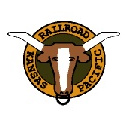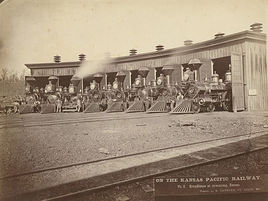Kansas Pacific - Anthony Lorch |
Prototype History
|
The Kansas Pacific was a very real railroad in the mid 1800's. This Kansas Pacific was folded into the Union Pacific Railroad with current Union Pacific routes traceable to Kansas Pacific routes. There is much information online about the real Kansas Pacific.
The roundhouse picture to the left is linked to the Wikipedia Kansas Pacific site. You can also find information in this article by David G. Taylor: |
Proto-Freelanced History

The first Kansas Pacific (KP) line ran from Kansas City to Denver with cattle being the primary commodity shipped. As the years went by the KP expanded throughout Kansas connecting the many small towns that produced cattle, grain, and other foods with big-city markets. The KP was the lifeline for the ranching and farming communities in the territory served. From Kansas the KP was expanded into Oklahoma in the early 1900’s again connecting the ranchers and farmers in the area with other railroads in Kansas City and Denver to ship their products east and north.
Oklahoma City became a major hub for the KP as it was decided to expand west towards California. At the same time expansion to Fort Worth, TX was a must for the large cattle ranches in the region. Land grants from the government helped facilitate the westward expansion as the KP was not going to move forward with this expansion on its own.
Fast forwarding to modern times, the KP merged with the Royal Gorge & Southern in the mid 1990's which gained access to the coal producing areas in Utah. The KP would connect this coal to markets in Mexico and ports for overseas export. KP also has a controlling interest in CIRAIL. Now with a shortened route west from Denver, the KP is better positioned to compete for traffic destined to the west coast.
Today's Kansas Pacific is headquartered in Kansas City. The main diesel shop is also in Kansas City with additional running repair shops in Oklahoma City, Denver, Albuquerque, and Phoenix.
The Locomotive roster is heavy with SD50 and SD60/SD60M locomotives. 1998 locomotive orders include SD75I, SD75B, SD70MAC, and C44-9W models. In 1st quarter 1998, the Kansas Pacific purchased Tier 0 locomotive rebuilds from Stephens Rebuild Shops (Hank Stephens of the Georgia Road). These locomotives classified as SD44LEOs were powered with Caterpillar engines. The SD44LEOs arerebuilt from Southern Pacific SD45T-2s with EMD wide cabs and 4400-hp CAT prime mover with the Low Emissions High Output (LEO) package.
Oklahoma City became a major hub for the KP as it was decided to expand west towards California. At the same time expansion to Fort Worth, TX was a must for the large cattle ranches in the region. Land grants from the government helped facilitate the westward expansion as the KP was not going to move forward with this expansion on its own.
Fast forwarding to modern times, the KP merged with the Royal Gorge & Southern in the mid 1990's which gained access to the coal producing areas in Utah. The KP would connect this coal to markets in Mexico and ports for overseas export. KP also has a controlling interest in CIRAIL. Now with a shortened route west from Denver, the KP is better positioned to compete for traffic destined to the west coast.
Today's Kansas Pacific is headquartered in Kansas City. The main diesel shop is also in Kansas City with additional running repair shops in Oklahoma City, Denver, Albuquerque, and Phoenix.
The Locomotive roster is heavy with SD50 and SD60/SD60M locomotives. 1998 locomotive orders include SD75I, SD75B, SD70MAC, and C44-9W models. In 1st quarter 1998, the Kansas Pacific purchased Tier 0 locomotive rebuilds from Stephens Rebuild Shops (Hank Stephens of the Georgia Road). These locomotives classified as SD44LEOs were powered with Caterpillar engines. The SD44LEOs arerebuilt from Southern Pacific SD45T-2s with EMD wide cabs and 4400-hp CAT prime mover with the Low Emissions High Output (LEO) package.
Fit in the Meridian Speedway Network
|
The Kansas Pacific's connection with the Natchez Trace & Orient Railway in Fort Worth, TX serves as the primary artery for KP's Mexico Traffic. There is a daily manifest train which operates between the NT&O hump yard at Fort Stockton, TX and KP interchange at Fort Worth, TX. The KP also hands off unit trains of automobiles and auto parts, grain, intermodal, and coal to the NT&O at Fort Worth for movement into Mexico via the NT&O gateway at Presidio, TX.
|
About Anthony Lorch
Anthony Lorch currently works for the Union Pacific as a conductor in San Antonio, TX. A native of San Antonio, Anthony has been with the UP for 13 years. Prior to working for the UP he worked for the IMRL in Kansas City.
He been modeling since he was a little boy, starting with N scale then moving HO around 1995 because HO scale was best suited to his interest in detailing locomotives. Anthony has been influenced by the Utah Belt and has been proto-freelancing since 1995. Currently his proto-freelanced railroad is named the Kansas Pacific which follows the route of the original Kansas Pacific but also has extended trackage.
Anthony credits his friend Hank Stephens who models the Georgia Road for helping him develop the Kansas Pacific become the proto-freelanced railroad it is today.
He been modeling since he was a little boy, starting with N scale then moving HO around 1995 because HO scale was best suited to his interest in detailing locomotives. Anthony has been influenced by the Utah Belt and has been proto-freelancing since 1995. Currently his proto-freelanced railroad is named the Kansas Pacific which follows the route of the original Kansas Pacific but also has extended trackage.
Anthony credits his friend Hank Stephens who models the Georgia Road for helping him develop the Kansas Pacific become the proto-freelanced railroad it is today.








